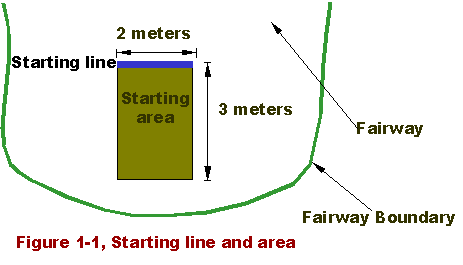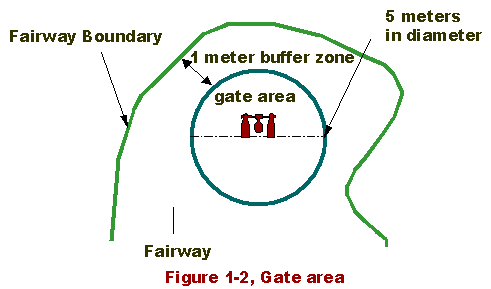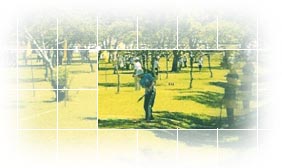|
I. General Principles
- The woodball course should be sited on a tract of
grassy field or clay ground, and its fairways should be planned
for games and competition.
- On the woodball course, the natural objects such
as trees, grove, low wall, and mounds can be used as obstacles or
boundary lines.
- The outer reaches of the fairway boundary can be
set up as a spectator's area with reference to the natural features.
- On the course should be set up a floor plan of layout
showing the pattern of the fairways and the panorama of the woodball
course.
II. Planning the Woodball Course
- On a woodball course should be planned twelve fairways.
- A twelve-fairway woodball course requires a total
distance of at least 500 meters and more.
- On principle, the surface of the fairway should be
even and smooth.
- The fairway is planned to be rectilinear or curviform
in accordance with the natural features of the land.
- On the fairways may be setup simple obstacles and
temporary boundary lines.
- According to the size of the woodball course, fairways
of different distance are planned. Fairway distances vary from 20
to 100 meters.
- In the event of the effect of the regional climate
or the natural features of the course, the local organizer may take
circumstances into consideration and make the appropriate local
rules but not against the primary spirit of the Rules.
III. Specifications of the Woodball Course
- The fairways should be maintained regularly, and
grass on the fairways should be mowed closely in advanced of play.
- The width of each fairway can be planned in accordance
with its natural features, but the narrowest should not be less
than 2 meters in width, and the widest should not be more than 20
meters.
- The distance of a fairway shorter than 35 meters
is called short distance, and between 36 to 65 meters called medium
distance, and between 66 to 100 meters called long distance.
- Of the twelve fairways, at least four are curving
fairways; of them two are left curving fairways and two are right-curving
fairways.
- Of the twelve fairways, at least two are long distance
fairways and two are short distance fairways.
- The length of the fairway is measured from the central
point of the starting line along the fairway center to the central
point of the gate. This length is regarded as the actual distance
of each fairway.
- At the beginning of each fairway, should be setup
a horizontal line as the initiating line, which is called starting
line. The line is 2 meters in length, at each end of the line draw
backwards a line of 3 meters in length so as to enclose a rectangular
area, which is called the starting area.

- At the end of each fairway should be setup
a circular gate area 5 meters in diameter with the gate as its center.
It may not be limited to 5 meters in case the geographical features
at both sides of the gate do not permit. Between the rear of the
gate area and the fairway boundary keeps a buffer zone one meter
and more in width.

- The gate is setup at the center of the
gate area and may face any direction of the fairway.
- The starting area and the gate area had better be
even and smooth without any obstacles.
IV. Use of the Fairway
- For each fairway before the game is completed, the
next team is not permitted to enter the fairway and play.
- On each fairway, only 4-5 players are allowed to
play at the same time.
- When the game is in process, no person other than
the field players and the referee should be allowed to enter the
fairway.
- When a field player is hitting, other players should
move back 3 meters to a safe position.
- Where the grass cover on the fairway was scooped
out by hitting, it should be flattened immediately by mending (or
by trampling).
- Before hitting, the player is not permitted to adjust
the fairway in from of his ball.
- The obstacles setup on the fairway should not be
removed as one desires.
- In the event of wind-blowing or rainy weather, the
player may request to clear away branches, leaves, and waste, etc,
hard materials fallen on the fairway.
|


